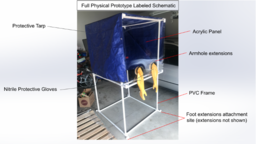Transmission Protection at COVID-19 Testing Sites in Ghana
TECHNOLOGY NUMBER: 2021-427

OVERVIEW
A low-cost, rapidly deployable interface for safe sample collection- Designed for Ghana, yet reproducibly applicable to nations worldwide
- Simple, reproducible design with minimal manufacturing and assembly needs
BACKGROUND
The residents of Ghana face increased risk of infections due to pathogens such as COVID-19 because of overcrowding in neighborhoods with limited access to health services, soap, water, and proper sanitation. Though Ghana established "pop-up" COVID-19 testing sites, the number of sites remained insufficient due to an overarching lack of resources. Symptomatic patients therefore commonly travel to hospitals for testing, increasing the concentration of crowds and a risk for increased viral transmission. Furthermore, there is a shortage of personal protective equipment (PPE) for health care workers in Ghana. This shortage requires practices that minimize the use of disposable PPE to save supplies for in-patient facilities. This problem is not specific to Ghana but is applicable to many countries worldwide. Therefore, a need exists for a low-cost and rapidly deployable interface between patients and healthcare workers that will minimize the use of disposable PPE and allow for safe patient sample collection in low-resource community settings.
INNOVATION
Investigators have developed a low-cost, rapidly deployable interface for safe sample collection. This device consists of a PVC frame, a small table in front of the device, armhole extensions, foot extensions, and an acrylic panel. The device can hold an icebox for vial storage, a non-contact thermometer, and sample vials. Foot extensions can be held down by sandbags to prevent the device from tipping and slipping when faced with high wind conditions or rough terrain. The armhole extensions allow the assembler to pull gloves through the armholes and wrap them around the extensions using a hose clamp, permitting the user to attach gloves to the device and ensure that they stay in place while also allowing them to switch out gloves.
The design utilizes an acrylic panel that covers the front top half of the device so that the patients and caregivers can see each other while still having a physical barrier between them. The panel is fixated is physically attached in a way that removes the needs to make screw holes into the acrylic. This approach saves time on manufacturing and assembly, and it also saves money by removing the need to buy screws, nuts, bolts, and U-brackets. Further modifications could include incorporating an acrylic or a solid barrier around the entire device, creating a mechanism for the device to fold down to ease portability, and adding a power source.
-
expand_more mode_edit Inventor (9)Caroline SoyarsDestiny OdnealElsie Effah KaufmannGeorge BoaduGilberto MataJames GeorgeJasnoor SinghKathleen SienkoMaxwell Ryner
-
expand_more cloud_download Supporting documents (1)Product brochureTransmission Protection at COVID-19 Testing Sites in Ghana.pdf